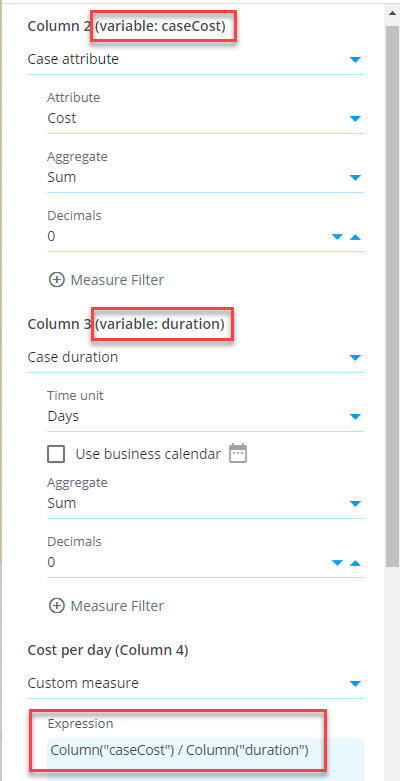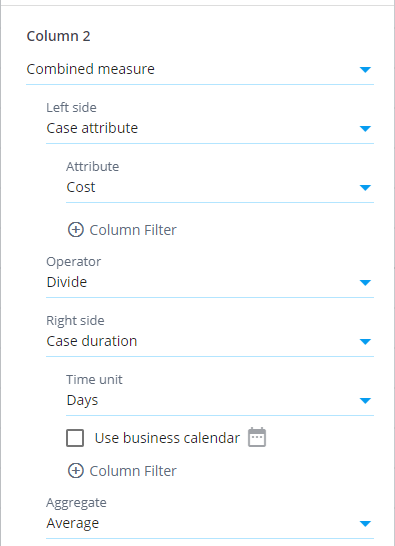Snowflake Chart: Difference between revisions
| Line 14: | Line 14: | ||
Note that the aggregation selection needs to be made also for custom measures because the custom expression doesn't contain the aggregation calculation, as the expression defines only how each row is calculated. | Note that the aggregation selection needs to be made also for custom measures because the custom expression doesn't contain the aggregation calculation, as the expression defines only how each row is calculated. | ||
In addition to the above mentioned aggregations, the following special aggregations are available for all data types: | |||
* "Any" aggregation selects one of the aggregated items as the final aggregated value (it's undetermined which one of the values is selected). When it's known that all the aggregated items contain a same value, the ''Any'' aggregation is the fastest method to get the value. Also, when it's known that there is only a single value among the aggregated values, the ''Any'' aggregation can be used to pick it. | |||
* "None" aggregation won't do the aggregation at all and thus won't return any data for the measure. The ''None'' aggregation can be used when the non-aggregated measure value is referred by other measure or dimension using the variable reference, and the aggregated value is not needed at all. | |||
== Using measure variables == | == Using measure variables == | ||
Revision as of 08:37, 19 April 2023
Big Data Chart is a chart visualization performing calculations in Snowflake, whereas the in-memory chart uses the QPR ProcessAnalyzer in-memory calculation engine. Snowflake-powered calculation will enable practically unlimited scaling when the amount of data and number of users grow.
When creating dashboards, select the Big Data Chart when using Snowflake models. It can be added to dashboard by selecting the second item from the tool palette (labelled Big Data Chart).
Measure aggregations
When using measures, an aggregation needs to be selected, defining how each row (e.g., case, event, ..) within the dimension is aggregated into the final measure value. Available aggregation methods depend on the type of data to be aggregated. Following aggregations are available:
- For numbers: average, sum, minimum, maximum, median, percentile, standard deviation (population), standard deviation (sample), variance (population), variance (sample)
- For textual data: count of items, count of unique items, alphabetically first item, alphabetically last item, list items, list unique items
- For dates, either earliest or latest date.
- Booleans are aggregated by calculating the number of true values.
For the percentile, also the percentile value between 0 % and 100 % needs to be selected. For the list and unique list aggregations, the separator between the listed items can be changed (by default, it's comma and space). In addition, the ordering of the listed items can be defined in the measure settings (in the List ordering tab).
Note that the aggregation selection needs to be made also for custom measures because the custom expression doesn't contain the aggregation calculation, as the expression defines only how each row is calculated.
In addition to the above mentioned aggregations, the following special aggregations are available for all data types:
- "Any" aggregation selects one of the aggregated items as the final aggregated value (it's undetermined which one of the values is selected). When it's known that all the aggregated items contain a same value, the Any aggregation is the fastest method to get the value. Also, when it's known that there is only a single value among the aggregated values, the Any aggregation can be used to pick it.
- "None" aggregation won't do the aggregation at all and thus won't return any data for the measure. The None aggregation can be used when the non-aggregated measure value is referred by other measure or dimension using the variable reference, and the aggregated value is not needed at all.
Using measure variables
In Big Data chart, you can define that a measure is available as a variable to use that variable in another custom measure. This allows to define measures in a more versatile way, calculating them with the help of other measures. Here is an example to calculate case costs per case duration (e.g., euros per day) for each customer group (see the chart settings on the right). First, create a measure case cost and assign a variable caseCost in the Measures settings (Advanced tab). Create another measure case duration and assign a variable duration to it. Finally, create a custom measure with expression:
Column("caseCost") / Column("duration")
When using variable, the calculation logic is as follows: the measures defined as variable are aggregated first for each dimension value (i.e., each row in the table) before the custom expression is calculated for each dimension. See an example of the resulting table below:
Combined measures
There is also the Combined measure selection available which works differently than the measure variables: If the above example is implemented using the combined measure, the division is calculated individually for each case, and the division results are aggregated into the final measure value. The aggregation method is the one defined for the combined measure. See the chart settings dialog below, how to configure the combined measure.
The difference between the methods in this example is whether the aggregation or division is calculated first. See an example of the resulting table using the combined measure (data is same as for in the above example):
Functionality differences to in-memory chart
Visualization settings are the same between the Big Data Chart and in-memory chart. The data selection settings, measures and dimensions work differently. Differences are as follows:
- There are different set of analyzed objects, measures and dimensions available.
- Filtering cases and events can be done for each measure and dimension separately. This allows to build most KPI's flexibly without using custom expressions.
- Measures and dimensions have equal lists of available items. The difference is that an aggregation selection needs to be done for measures. Enabled by this, measures can be moved to dimensions and vice versa by clicking the Move to dimensions and Move to measures buttons.
- Custom expressions are written as SQL expressions which differs from the eventlog objects available in the in-memory charts. Note also that measure expressions in Big Data Chart don't include the aggregation logic, and thus the custom measure and dimension expressions are equal.
- Big Data Chart supports filtering similar to the in-memory chart, i.e., visualizations can be clicked to create filters for the selected items to drill down into them. However, Big Data Chart supports different kinds of expression based filter rules and thus expression based filter rules created in the Big data chart cannot be applied to the in-memory chart and vice versa.
- Event attribute used as the event type can be set for each Big Data chart separately, to visualize the process flow from different angles. For more information, see chart settings.
- The Any datatype is not supported by the Big Data Chart in case and event attributes. Thus, when importing data, specific datatypes need to be set for each column, for case and event attributes to be available.
- Following measure/dimension settings are not available: Calculate measure for, Custom aggregation expression, and Adjustment expression.
- Big data chart cannot be used with models using ODBC or expression datasources.
Calculation results are mostly the same between the Big Data Chart and in-memory chart, but there is one exception: If there are cases with events having exactly the same timestamp, in the Big Data Chart the order of events is the alphabetical order of event type names. In the in-memory chart, the order is based on the loaded data in the events datatable. The order of events affects for example the variations and flows the cases are belonging to.
Big Data Chart for SQL Server processing
For special use cases, Big Data Chart can also be used for models with local datatables, performing processing in SQL Server. The benefits are that the model doesn't need to be loaded into memory, consuming less memory in the application server. Also no time need to be spent for the model loading. The disadvantage is that SQL Server is not optimal for analytical queries, meaning in practice insufficient performance in large dataset. Despite the limitation, there are use cases when Big Data Chart is a suitable for models with local datatables:
- Eventlogs are filtered heavily so that the number of remaining cases and events are low (usually maximum of some thousands), maintaining the performance in sufficient level.
- If the model is currently not available in the memory, it's faster to use Big Data Chart comparing to the in-memory chart, when the required time to load the model into memory is taken into account.



